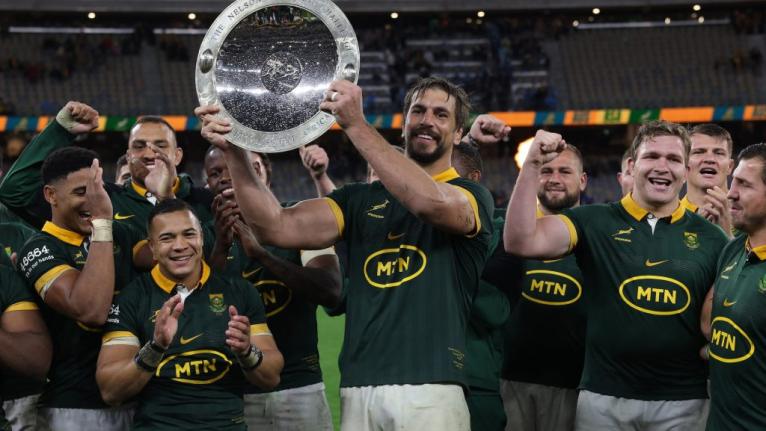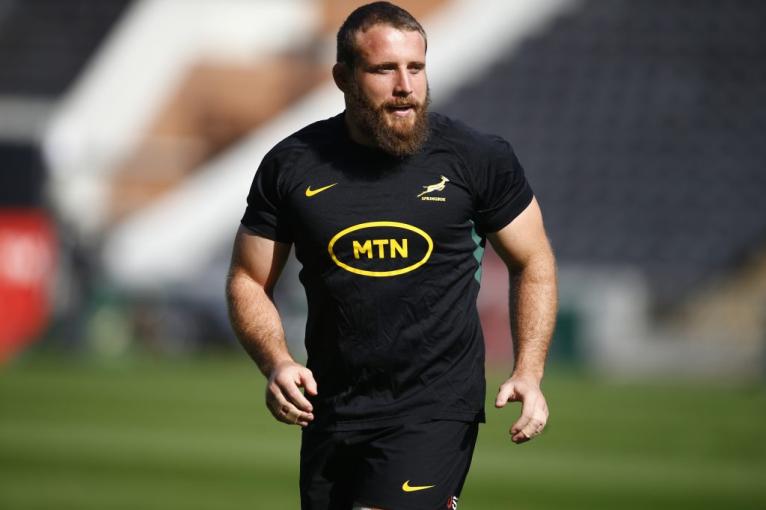The depth! Oh the deep, never-ending, bottomless depth! What riches are buried in crevices beyond the reach of other rugby nations. What bountiful resources lay before Rassie Erasmus and his Springboks coaching staff. It’s a good thing South Africa isn’t allowed to send out more than one side at Rugby World Cups. Otherwise there’d be two squads sporting the leaping antelope contesting the final in Sydney in 2027.
Of course this is hyperbolic nonsense and shouldn’t be taken seriously, though no doubt some Springboks supporters will read it and nod along in agreement. There is, however, a bit of truth in there, swirling around like a fleck of gold in a muddy pan. After all, in two of their last six Tests the Springboks have fielded what were ostensibly B teams against so-called Tier One opposition and categorically spanked them.

Caveats should be attached to the 41-13 win over a ramshackle Wales side in London in June, and the 30-12 victory over a work-in-progress Wallabies outfit last weekend is not exactly a harbinger of guaranteed glories to come. Let’s not forget these two opponents are currently ranked 11th and ninth according to World Rugby’s metrics and would likely also struggle against the supporting casts of Ireland, New Zealand and France.
But two things can be true at the same time. It is true the chat around the Springboks’ depth has been overblown on occasion and it is also true these are heady days for supporters of the world champions. Which truth, though, is truer than the other?
For the first Test against the Wallabies, a Test Erasmus could not risk losing, 13 World Cup winners started with a further six on the bench. That means Sacha Feinberg-Mngomezulu at fly-half, Elrigh Louw at number eight and Gerhard Steenekamp and Ben-Jason Dixon among the replacements, were the only fresh faces in the 23. For a squad embarking on a new World Cup cycle, this is a remarkable turn from convention.
Form, injuries and imposed sanctions aside, there is every chance Erasmus was planning to name a 23 without a single player who didn’t lift the Webb Ellis Cup last year.
Feinberg-Mngomezulu is an outrageous talent but largely untested at this level. That Manie Libbok and Handre Pollard have already proven themselves to Erasmus is part of the reason why the new fly-half has been given an extended run. As for Louw, he has benefitted from the retirement of Duane Vermeulen and the suspension of Jasper Wiese. Steenekamp has been aided by the injury of Steven Kitshoff while Dixon is a replacement for the injured Franco Mostert. Form, injuries and imposed sanctions aside, there is every chance Erasmus was planning to name a 23 without a single player who didn’t lift the Webb Ellis Cup last year.
Thanks to that comfortable win in Brisbane, Erasmus could make 11 changes to the group. But how many put in performances that will ensure their long-term inclusion? Aphelele Fassi impressed at full-back and should get another opportunity. With Damian Willemse out injured, and Wille le Roux managing his load, there is an opportunity at the back of the field. And under wet skies in Perth, he proved he can handle himself under the high ball in testing conditions.
Ruan Nortje also shone in the rain. His work rate is exceptional and he hammers every ruck within reach. His versatility means he can operate in the back and second rows which nudges him ahead of the rest of the contenders.

Loosehead is also a position of interest for newbies. With Kitshoff still making his way back to full fitness, Steenekamp will be challenged by Jan-Hendrik Wessels who has rightly garnered attention. His mobility around the park, as well as his ability to cover hooker in a pinch, means he is firmly on the Boks coach’s radar.
But that’s about it. Feinberg-Mngomezulu’s introduction has effectively shut down any prospective fly-half’s chances of entering the fray. And with a plethora of scrum-halves, not to mention Morne van den Berg’s struggles in the Perth wet, the other half-back position is firmly in the grip of old hands.
The centres are similarly locked down with Jesse Kriel, Damian de Allende and Lukhanyo Am holding on to midfield with an iron grip. And with Am experimenting at inside centre, not to mention the bulk of Andre Esterhuizen perpetually waiting on the fringe, it is hard to envisage a scenario where an opportunity might come about for someone outside of the quartet.
As the final line of the piece are being written the Springboks squad for the two Tests against the All Blacks has been released. There are no surprises.
It’s the same story on the wing where Cheslin Kolbe and Kurt-Lee Arendse are streets ahead of the competition. Canan Moodie might replace Makazole Mapimpi as the first-choice support member, largely as a consequence of his ability to cover both 13 and 15, but also because of the incumbent’s diminishing powers.
Hooker is secure with two world class talents looming large. Lock is secure. The flanks are secure. And if Pieter-Steph du Toit operates as a hybrid lock – which deserves another look against quality opposition – spaces could be limited even further.
As the final lines of the piece are being written the Springboks squad for the two Tests against the All Blacks has been released. There are no surprises. Just two hookers have been named. No rookie scrum-halves are in the mix. And only because of injuries to important locks are there inexperienced players in the position.
Does all of this pour cold water on the hot takes about the Springboks’ enviable depth? Not necessarily. But it does suggest those with their hands on the wheel aren’t letting go any time soon.


There is a difference between having a great depth chart, having extended depth at test level, and evolving the team to manage the age profile.
The depth chart is what Rassie described when he mentioned two experienced players plus a younger contender in each position (the fifteen positions on the field plus the "utility" positions). It amounts to a group of about 45-50 players, with an average of over 30 caps. That's what he wants in place on the day that he picks the squad for the RWC. Some players on standby is also a good idea. The Boks have this today, and the situation is better than at any time in recent memory.
Extended depth, beyond the core depth chart, is a little harder. Essentially the question is how much the performance will drop off if you have three injuries in one position. Who is the fourth of fifth choice hooker, outside centre, or full back? The answers OK in some positions, but not fantastic in others. The coaching team claims to be tracking over 100 players, but they haven't got that many up to speed with the Bok culture, philosophy, playing structures and playbook. Nor do those players have the test caps that are needed to ensure consistent performance, because there are only about 60 caps to be awarded in each position, between RWC tournaments. So if we are talking about extended depth then it's not brilliant, but it is a really big ask for any team.
Evolving and renewing the team is a related topic, but it is really about future depth. And of course it is super-important. It's one thing to say that the Boks have great depth today, but what depth will they have at the 2027 or 2031 RWC tournaments. Typically the average age of a Bok team at the RWC is 29 years, so it follows that the players Rassie will pick for the 2027 RWC currently have an average age of 26. We see younger players being introduced, like Sacha, Moodie, Louw, Moerat, Nortje, Wessels and Van Staden. But Rassie needs more of those, and they need to get a lot of playing time under their belts for them to be ready for the next RWC.
The Springboks have depth in that they have a lot of capable replacements to call upon in each position but as the first half in Perth proved, a capable but inexperienced replacement is nowhere near as good as an experienced player and will not be able to deliver the same consistency in performance. So the Boks have less relevant depth than we think however the process of building depth and getting the less experienced players up to speed has already begun. The Boks have gone with the B-team now in 3 tests this year and a number of fringe players are getting more experience. This is happening faster than we thought with most suggesting that it would only start to happen next year while the Boks targeted dominance this year. So the Boks are building relevant depth and with that building for 2027 quite well at the moment.
Is there a point to this article?
No point at all. We all know that over the next 3 years in the lead up to the next RWC there will be a few retirements and injuries. What Rassie and his coaching staff are doing is looking at the players over 32 today and giving their replacements time to settle in at the test match level.
One can have depth and struggle to drop players on form for key games.
KLA and Kolbe, for example, are damn near impossible to drop. Good problem to have.
And while the author might be right that we keep hearing about SAs depth and it might be overblown - but show me a team right now with better depth?